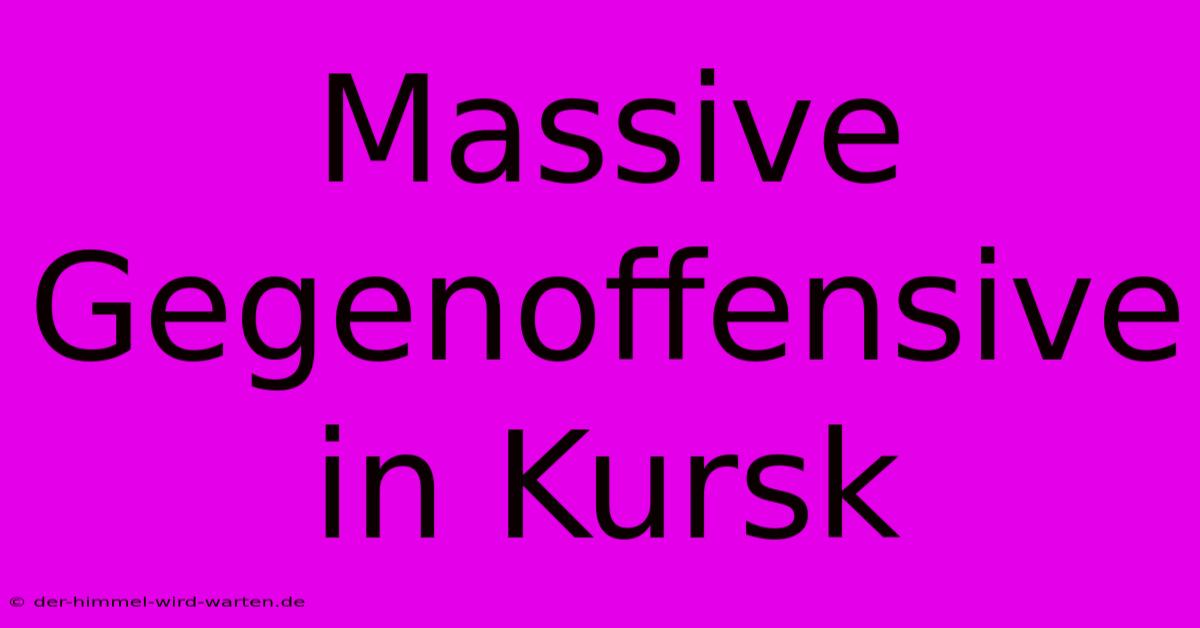Massive Gegenoffensive In Kursk

Discover more detailed and exciting information on our website. Click the link below to start your adventure: Visit My Website. Don't miss out!
Table of Contents
Massive Gegenoffensive in Kursk: A Look Back at a Pivotal WWII Battle
Hey everyone, let's dive into a seriously pivotal moment in World War II – the massive Gegenoffensive (counteroffensive) at Kursk. I've always been fascinated by this battle, and, honestly? I messed up pretty badly when I first tried to write about it for my history blog. I totally glossed over the human cost, focusing too much on the sheer scale of the tanks and planes. Big mistake! It's a reminder that history isn't just about numbers; it's about the people.
The Context: A Battle of Giants
So, Kursk, 1943. The Germans, after their stunning victories early in the war, were feeling the pressure. The Operation Citadel, their planned offensive in the Kursk salient (that’s a bulge in the front line, think of it like a giant, deadly pocket), aimed to crush the Soviet armies and hopefully regain the initiative. This was supposed to be their last big hurrah on the Eastern Front. They planned a massive pincer movement, a classic military tactic, designed to encircle and destroy the Soviet forces. This involved a Panzerarmee (tank army), heavy armor formations, and, of course, the Luftwaffe. It was going to be a bloodbath.
The Soviet Response: A Defensive Masterclass
The Soviets, however, weren't going down without a fight. They knew what was coming. They'd already been working on extensive defensive fortifications. We're talking trenches, minefields, anti-tank obstacles – the works. Think of it as the ultimate "Welcome to my house, now try to take it" type of situation. They also had intelligence that the Germans were planning something massive. This gave them a huge advantage.
What's really interesting is how they used defense in depth. Multiple layers of defenses meant that even if one line was broken, the Soviets had others waiting to counterattack. They also had their own counteroffensive planned. They prepared their own Panzerarmeen for a counteroffensive, which was one of the reasons Operation Citadel failed.
The Battle Itself: A Brutal Grind
The battle that ensued was brutal, truly brutal. The Germans, despite their superior armor in some sectors, faced ferocious Soviet resistance. The fighting was concentrated on a few key areas, with both sides suffering massive casualties. The Soviets suffered heavy losses early on, but it didn't break their will to fight.
Imagine the scale: thousands of tanks clashing across the vast steppe, the air filled with the roar of Stukas and Soviet fighters dogfighting. It was a war of attrition, a grinding, bloody conflict that lasted weeks. There were moments of incredible bravery, stories of individual heroism and unbelievable sacrifice from both sides. The battles around Prokhorovka, for example, were intense tank clashes, where the sheer volume of tanks was almost unbelievable. Think hundreds of tanks just beating each other up.
Beyond the Numbers: The Human Cost
And this is where my initial mistake comes in. I focused too much on the tank battles and the numbers of casualties (millions on both sides!), forgetting the human element. It wasn't just tanks and planes; it was about real people fighting and dying, suffering immense hardship. Focusing solely on the military aspects ignores the suffering of civilians caught in the middle, the trauma experienced by soldiers who survived, and the long-term impact on the region. That’s what needs to be emphasized.
Lessons Learned: More than Just Military Strategy
Looking back, the Battle of Kursk offers numerous lessons. One is the critical importance of effective intelligence gathering. The Soviets had an advantage because they knew what was coming. The success of the Soviet defense also highlighted the significance of well-prepared defenses and a strong defensive doctrine, the defense in depth.
Ultimately, the Gegenoffensive at Kursk marked a turning point on the Eastern Front. The German offensive failed to achieve its objectives, and the Soviets went on the offensive, eventually pushing the Wehrmacht back towards its own borders. This marked a major shift in the momentum of the war. This wasn't just a military victory, though; it's a reminder of the devastating human cost of war and the importance of remembering those who fought and died. Don't let the numbers obscure the human story, which was ultimately what made this battle such a dramatic turning point in history.

Thank you for visiting our website wich cover about Massive Gegenoffensive In Kursk. We hope the information provided has been useful to you. Feel free to contact us if you have any questions or need further assistance. See you next time and dont miss to bookmark.
Also read the following articles
| Article Title | Date |
|---|---|
| Parteiprogramme Steuern And Supermarktpreise | Dec 17, 2024 |
| Partikelfilter Ford Startet Grossen Rueckruf | Dec 17, 2024 |
| Moukokos Alter Fakten Zum Bvb Star | Dec 17, 2024 |
| Tragoedie Russland Timma 32 Verstorben | Dec 17, 2024 |
| E On Verkauft Geschaefte In Rumaenien | Dec 17, 2024 |
